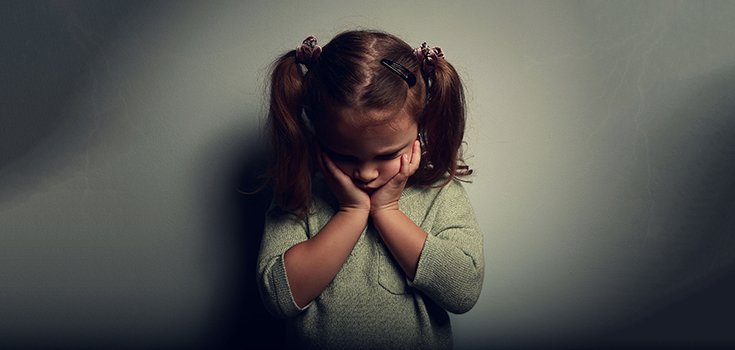Calling the Hotline: Researchers Alarmed at Sharp Increase in Anxiety in Children

Experts in the United Kingdom (UK) are alarmed by a sharp increase in anxiety among British children. Equally alarming is the rise in medication addiction and the number of youngsters seeking outside counsel to cope with their anxiety. [1]

In Britain, children who need a listening ear can call Childline. It’s a phone counseling service run by the UK children’s charity NSPCC. In the past year, the hotline took 55% more calls from kids struggling with anxiety. Nearly 9 in 10 of those calls were made by girls, according to a recently published report.
Childline also received 24,549 calls from children with suicidal feelings and thoughts, a record high for that category.
Peter Wanless, NSPCC’s chief executive, said:
“Anxiety can be a crippling illness and it is deeply worrying that the number of counseling sessions we are delivering for this issue is rising so quickly.”
Read: The Anxiety Epidemic – Causes, Symptoms, Solutions
The problem of anxiety and depression is not unique to Britain, of course. In the US, more than 1 in 20 children and teens have anxiety or depression, a report published in April 2018 in the Journal of Developmental & Behavioral Pediatrics shows.
According to that study, the number of children with depression has not increased in recent years, but the number of young people with anxiety has. The reasons why more kids are wrestling with anxiety are not clear. Perhaps there is much more to be anxious about, or perhaps children are not as prepared to deal with these negative feelings. [2]
And despite there being no real increase in depression among American children, the same cannot be said of the teen suicide rate, according to a June report published in the journal Pediatrics. Data from the U.S. Centers for Disease Control and Prevention (CDC) show that suicide among youth ages 10-19 was the second leading cause of death in the U.S. in 2015, and that pace has quickened since 2006. [3]


That study further revealed that hospitalizations for suicidal thoughts and attempts among school-age children and teens has more than doubled between 2008 and 2015.
Pills, Pills, and More Pills
If you have anxiety or depression, there’s a pill for that. There are many pills for that. While that’s excellent news for some, it is a nightmare for others who end up misusing and abusing them.
A separate report published by Public Health England (PHE) revealed that the number of children needing treatment for Benzodiazepine addiction has nearly doubled in a year, from 161 to 315. The medications, often referred to as “benzos,” are prescribed to treat anxiety. [1]
Xanax was the benzo which saw the most significant rise, with its use among young people increasing almost 7-fold.
Read: Anti-Anxiety Drug Overdoses are on the Rise – Leaving Many Questions
This, too, is a problem in the United States. In late August 2018, researchers said they were expecting an onslaught of benzodiazepine addiction in teens during the school year, and Xanax was at the top of the list of abused drugs. [4]
In an article, Pew Charitable Trusts wrote:
“Many teens view Xanax as a safer and more plentiful alternative to prescription opioids and heroin – with similar euphoric effects.”
But many young people are taking benzos in combination with opioids and alcohol, which can prove fatal.
What kids often don’t realize is that benzodiazepine withdrawal can also be deadly. If abusing sedatives doesn’t kill you, trying to get off of them just might.
Sharon Levy, director of adolescent addiction treatment at Boston Children’s Hospital, said:
“Adolescent benzo use has skyrocketed, and more kids are being admitted to hospitals for benzo withdrawal because the seizures are so dangerous.”
Evolving Problems

Dame Esther Rantzen, who founded Childline 32 years ago, said that when she founded the hotline, the calls they received were “about terrible things other people were doing to them, be it sexual abuse, physical abuse, bullying.” [5]
Read: 3 Great Tips for Reducing Anxiety Naturally
But now the hotline is “seeing this exponential increase in mental health issues,” according to Rantzen.
She added:
“The social interaction of young people today with people who love them unconditionally and to whom they belong has diminished hugely with the fragmentation of the extended family.”
Young people are facing a multitude of pressures, and Childline is ultimately filling in the gap for those who feel they have nowhere to turn.
Although the study doesn’t mention social media specifically, it’s an established fact that kids turn to this medium for much of their social interaction. The problem with social media is that it’s an easy place for bullies to set up shop and torment their peers, and teens seeing the seemingly-perfect images of their friends can bring about deep self-loathing – especially for girls.
Instagram is considered the worst social media site for teens’ emotional health, according to a report by the Royal Society for Public Health (RSPH) in the UK.
One girl who participated in the survey said:
“Instagram easily makes girls and women feel as if their bodies aren’t good enough as people add filters and edit their pictures in order for them to look ‘perfect.'”
Sources:
[1] CNN
[2] Science Daily
[3] USA Today
[5] Express
